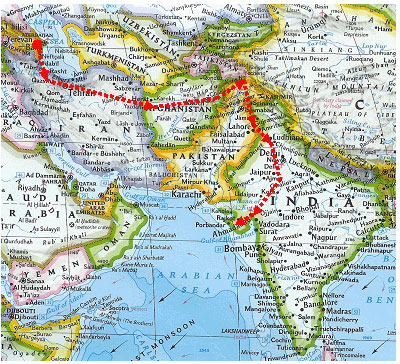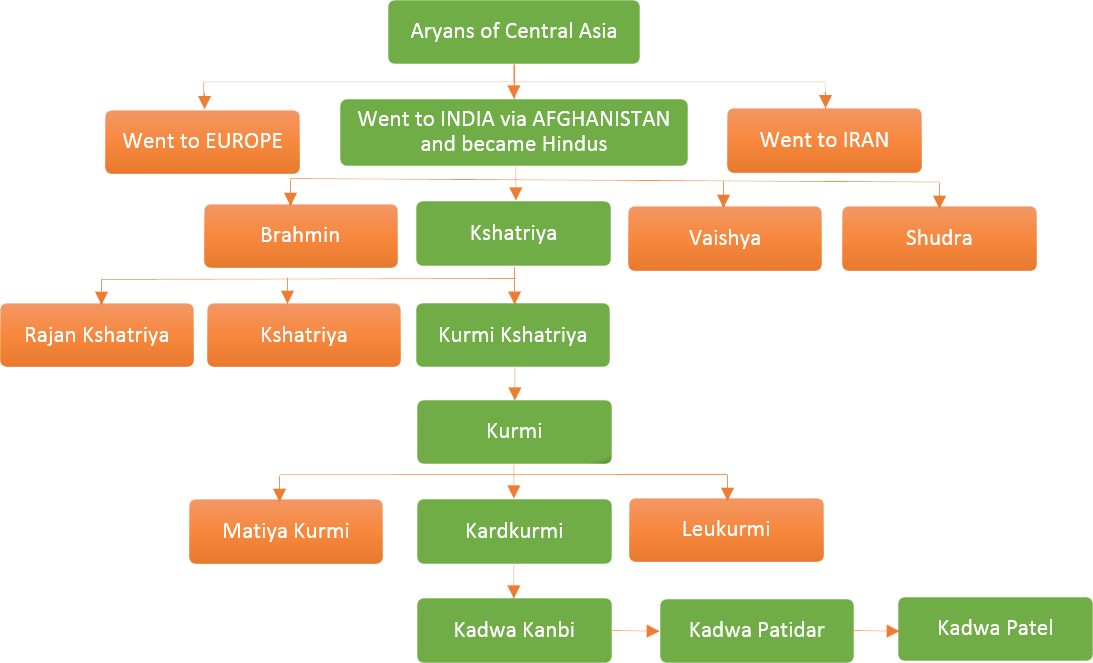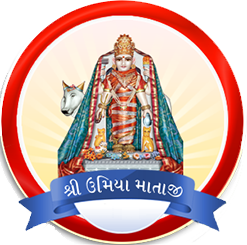The Proud History of Kadwa Patidars

There are many theories and legendary stories about the history of Kadva Patidars (Kurmis, Kanabis). According to the most believable theory, based on the historical records and credible evidences, Kadva Patidars roots go all the way to the origin of Hindus. According to the same theory, Hindus came to India from Pamir region on Ayu River in the central Asia (in Azerbaijan) via the Caucasus Mountain and Afghanistan (see right image). At that time they were called Aryans (not Hindus) and they worshiped life sustaining elements like sun, wind, fire, and rain, etc. They believed in one God “BRAHAMAN”. Their religion was known as Aryan Dharma, Sanatan Dharma, or Vedic Dharma, but not Hindu Dharma.
When the Aryans came to India they settled in the plains of a big river that they named as Sindhu (means big like an ocean). With passage of time, the Aryans got integrated, socially, culturally, vocationally, and religiously, with the natives living there. Together, they established a well organized and developed settlement that became known as Sindhu Valley Civilization, also known as Indus Valley or Harappa Civilization.
Sindhu Valley civilization is the mother civilization of Hindus and Kadva Patidars (and most of the North Indians). It was established between BC7000 and BC2000 and started shrinking in BC1600. It covered 1.2 million square kilometers (400,000 square miles) from Kashmir in north to Godavari River in south and from Delhi in east to Arabian Sea in west. It was a most advanced civilization with farming, commerce, and social amenities. Its inhabitants had established standards, based on decimal system, for weight, length, area, and volume measurements. They had engineering and technical skills for transportation, farming equipment, metal working, and town planning. They had a language with 26 readable and writable characters. It was written from left to right. They were followers of Shiva.
Later on that area became known as Punjab area, also known as Saptasindhu Valley (currently some part is in India and some in Pakistan). While Aryans were in the Sindhu Valley, they established trades with Mesopotamia and Iran. Those people cannot pronounce sound of “S” instead they say sound of “H”. They started referring the people of Sindhu Valley as “Hindu”. This is how Aryans became Hindus. With time the Hindu society, settled in the Sindhu Valley, got divided into four social classes by profession as described below
Later on, the Kshatriya class got divided into three sub-classes, Rajan Kshatiya (Kings and leaders), Kshatriya (worriers), and Kurmi Kshatriya. The Kurmi Kshatriya did farming during the peacetime and helped army during the war times. Later they became known only as Kurmis, working on farms (growing food and raising cows for the benefits of the entire society). All Patidars are descendants of those Kurmis.
Starting in year BC1000, foreign invaders from west (Turkey, Iran, Iraq, etc.) started attacking the people settled in the Punjab area and robbing, torturing, killing, and destroying houses, farms, and temples. This forced the Kurmis and others to leave the Punjab area and migrate to eastern and southern parts of India. Some Kurmi groups migrated to and settled in North Gujarat (near Unza area) and continued farming occupation. Not to forget the origin of their ancestors, they adopted their last names (family names) based on the town name (in Punjab) where they lived before migrating.
While in Punjab, those Kurmis lived in Karad area of the Punjab (Gujranwala) were known as Karad Kurmi and those who lived in Leu area were known as Leu Kurmi

With time and migration to the south, the “Karad” word got distorted to “Kadva” and the “Kurmi” word got distorted to “Kanabi”. Thus Karad Kurmi became Kadva Kanabi and Leu Kurmi became Leuva Kanabi. While settled in North Gujarat, Kadva Kanabis made Unza as the center of the community and established a Temple of Umiya Mataji, their family goddess.
In 17th Century, the Kanabi community requested to call them Patidars, which means managing leased land (mostly from kings). This changed Kadva Kanabi to Kadva Patidar. When Gujarat was taken over by Muslim kings, they started torturing the public. To escape from the torture and shortage of the farming land, some Kadva Patidar families migrated from North Gujarat to other part of Gujarat including Saurashtra. Some of them adopted new last name (based on name of the town they lived in the North Gujarat), while others kept the original last name.
When the Patidars started owning land, they adopted title of “Patel”, a short form of “Patidar” word. Other populace started referring Patidars as Patel caste. (Kadva Patidars as Kadva Patels). However, the word Patidar is still a very popular and frequently used word for Kurmis/Kanabis. Recently, some of Kadva and Leuva Patidars have adopted “Patel” as their last name.
To continue to prosper, some Kadva Patidars migrated to other part of the world including Africa, UK, USA, Malaysia, Canada, and Australia. The most of the KPSNA families are from Saurashtra.
Early Patidar ancestors, being farmers, were providers, of all the basic life necessities to the entire population. That is the reason; Patidars are also called caretakers of the world.
As described above, our ancestors migrated, from Central Asia to Sindhu Valley, to Ganges Plains, to North Gujarat, and to Saurashtra in search of peace and prosperity. Wherever they went, they prospered due to their hard work, dedication to society, resilience to torture, adventurous nature, and having skills to survive in any circumstances.
Late in the 18th century, Kadva Patidars ancestors understood that education was the central spine of social reform and progress. That gave them an appetite for education. They poured money into building educational institutions and providing scholarships and other encouragements for education. This revolutionized and modernized the entire Kadva Patidar community and helped the community to transform the ensuing generations from simple farmers to industrialists, businessmen, doctors, engineers, accountants, scientists, professors, teachers, soldiers, writers, and politicians. The current Kadva Patidar generation is a result of the education euphoria started less than 130 years ago.
Early in the 19th century, Kadva Patidars started Kadva Patidar conventions to uplift and to modernize the community. Such conventions inspired the entire Kadva Patidar community to get education and to reform the old social customs (such as child marriage, bride selling, multiple wives, and expensive funeral ceremony) which were holding them back. Many Patidar /Kurmi publications were also catalysts for this transformation.
Once we comprehend Kadva Patidars triumph based on their history, migration hardships, their social progress, changes in their life styles and living standard, their appetite for education, and their forward thinking, we can not help ourselves but be proud of our rich and inspiring history and heritage.
Therefore, do not let any one fool you, neither let any one put you down. We, Kadva Patidars are not uneducated hillbillies anymore. Our history is very rich and inspiring. Our ancestors struggled to put us in our current state. They never tortured anyone, killed any masses, robed people and destroyed their homes, destroyed any places of worship, or forced anyone to convert his/her religion. There is nothing in the history of Kadva Patidars that is to be ashamed of. Instead, it gives us pride of being descendants of our ancestors.
With Umiya Mataji’s blessings, we, Kadva Patidars, will continue our march for peace and prosperity that our ancestors started long time ago.
SURNAME AND PSEUDO-SUB-SURNAME (ATAK)
Our ancestors have inhabited Unjha and the surrounding regions for 2000 years. They lived in Punjab for a long time and got their original surname from the name of the place they lived in. People of Punjab living in the area of Rohtagadh were known as Rusat, those coming from Mandleh were known as Mollat and those from Bham area were known as Bhemat. Those who came from Amratsar were known as Amratiya. As time passed, population increased and therefore their share of land was reduced. As a result they kept on moving further to other states. Those people coming from the region of Karad in Punjab maintained the Karadva Kadva surname in memory of the land from which they had originated. They started adopting pseudosumames. After moving within Gujarat and staying in one place for a long period when they moved to a new area they adopted a pseudosumame in memory of the previous area. For example: people who left Adraj area of Kadi district in north Gujarat adopted the pseudosumame of Adroja. Those who left Kalari area of Chanashma in North Gujarat adopted the pseudosumame Kalaria. Those people who moved from Devghat Bariya area in Panch Mahal adopted the pseudosumame Baria. Those who moved from Unjha town adopted the Unjiya surname. Those from Aghar area of Viramgam district went and stayed in Sausrashtra, they adopted the pseudosurname Aghar (Aghera) and therefore maintained a tie with Aghar area. In this way everyone maintained their ties with their previous villages. As time passed Kurmi Kanabi spread throughout Gujarat, Saurashtra and Kutch. In these areas there will seldom be a village where there is not a Kadwa Patidar resident.
OUR POPULATION CENSUS
In a census one hundred and fifty years ago in Year 185152, according to British Collector in Ahmedabad, Kadwa Kanbis merely numbered 6 lakhs. According to the census there were 3,30,000 men and 2,65,000 were women. There were 100 boys for every 78 girls newly born. That is why it is possible to believe girls were drowned in milk at birth. British India government issued a public notice to stop this custom. According to recent census, in Gujarat State, Kadwa Patidar families are about 450,000 and it is believed total population is 3540 lakhs. Of the total population of Gujarat State approximately 10% are Kadwa Patidar and 22% are all Patidars.


